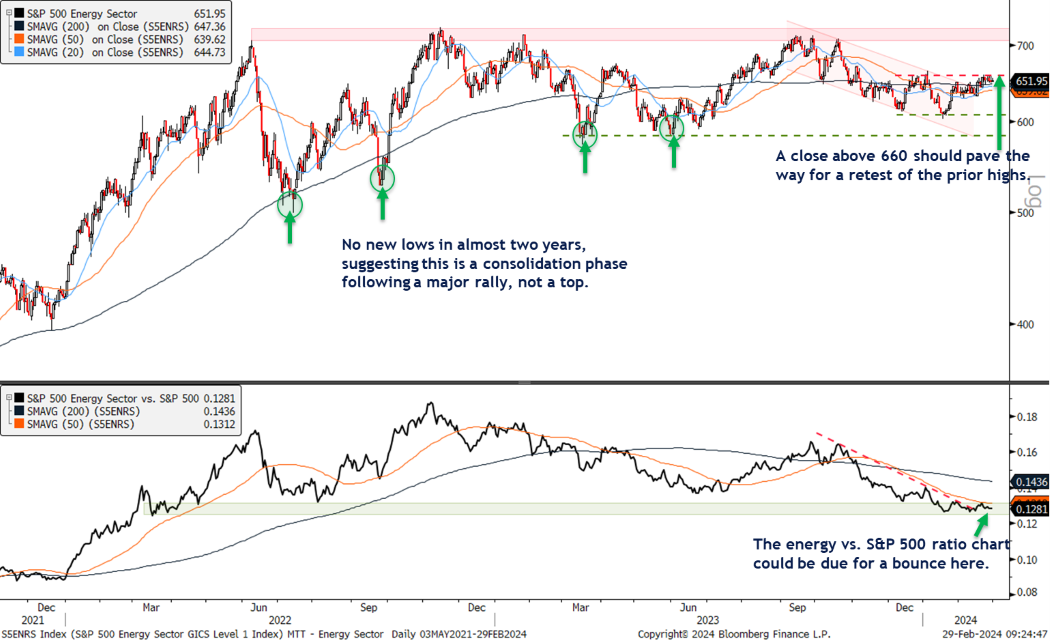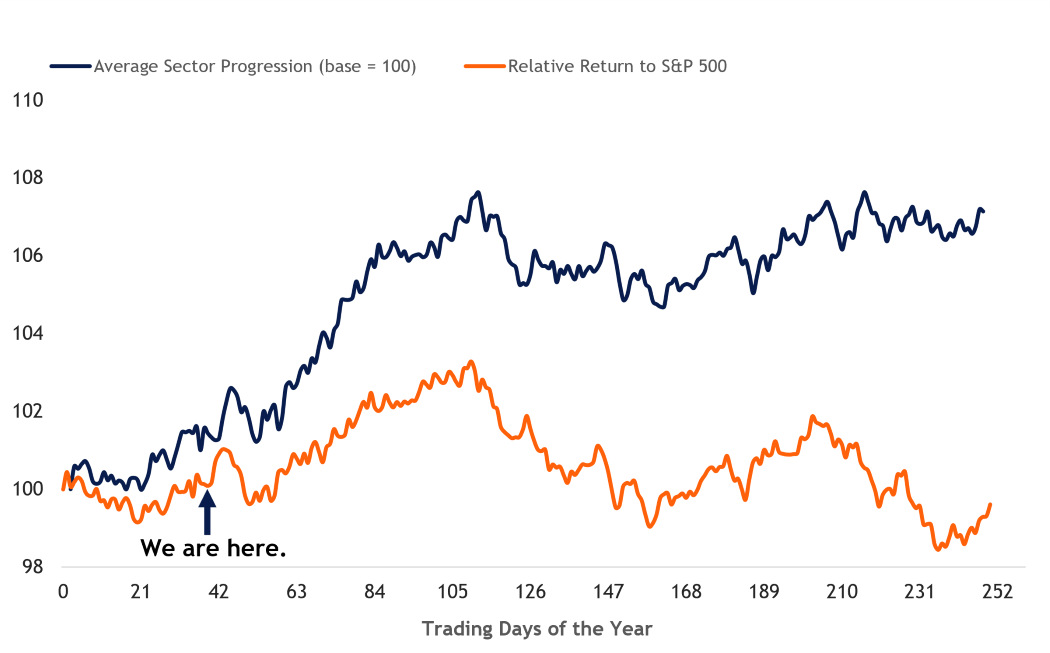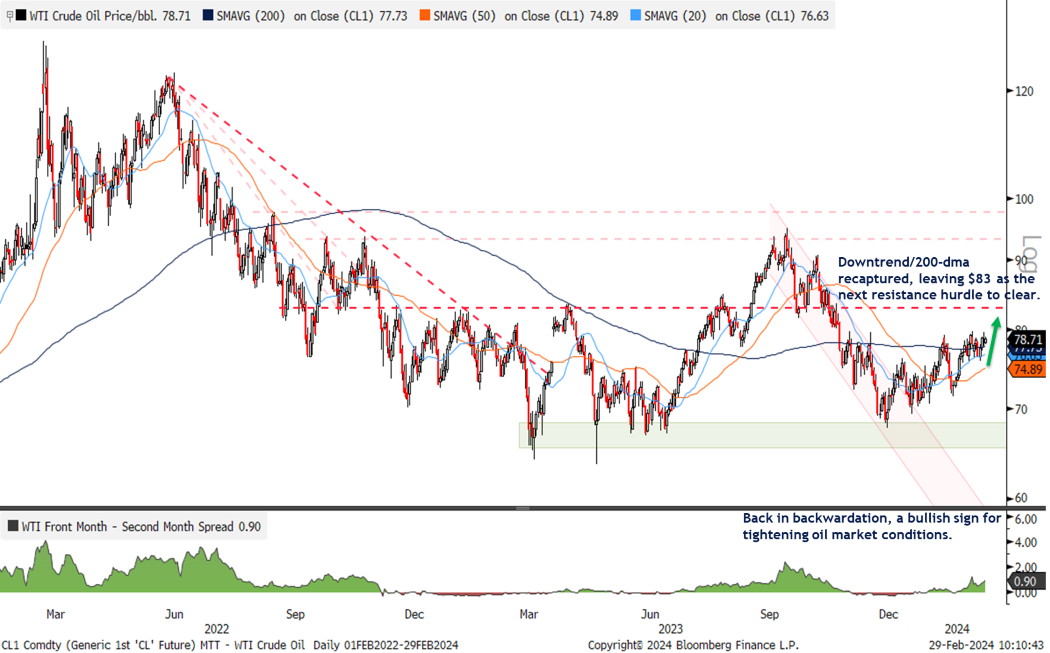
Is Energy Due for a Rebound?
Key Takeaways
- Energy is struggling to keep up with the broader market this year. However, an improving technical setup for energy stocks points to a potential rebound for the sector.
- Seasonal tailwinds suggest this inflection point could be near.
- Crude oil is also making technical progress, and the futures curve is indicating the supply and demand backdrop is improving.
- Fundamentals remain bullish for the sector. Energy stocks are trading cheap relative to the S&P 500 and delivering a dividend yield of around 3.5%. Furthermore, the sector has notably shifted capital allocations over the last few years in favor of shareholders.
Energy stocks have struggled to keep up with the broader U.S. equity market this year. The S&P 500 Energy Sector is up only 1.6% as of February 28, lagging the S&P 500’s year-to-date gain of 6.3%. Underperformance is attributable to several factors, notably record U.S. oil production counterbalancing OPEC+ production cuts and oil’s geopolitical risk premium, a plunge in natural gas prices due to oversupply and weak heating demand, and global economic concerns, notably in China, the world’s largest importer of oil.
Outside of the macro backdrop, energy stocks have been out of favor as fund managers continue to pile into the large cap growth space. According to the latest Bank of America Fund Manager Survey, a collection of around 250 fund managers running $656 billion, the net percentage of overweight allocations to the technology sector rose to 36% this month, marking the highest level since August 2020. Furthermore, 61% also noted that “Long Magnificent Seven” was the most crowded trade. In contrast, 13% of fund managers were underweight energy, falling to over a one-standard-deviation discount to its longer-term average.
While energy may be underperforming and under-owned, the sector could be due for a rebound in relative performance. As highlighted below, energy has finally started to make some technical progress. Over the last several weeks, the sector has reversed a declining price channel and recaptured its key moving averages. In terms of upside, a close above resistance at 660 should pave the way for a retest of the prior highs near the 715–720 range. Furthermore, momentum indicators remain bullish, and perhaps most importantly, the energy sector vs. S&P 500 ratio chart (bottom panel) is holding above key support after recently reversing a downtrend.
Energy Stocks Are Finally Making Some Technical Progress
Source: LPL Research, Bloomberg 02/29/24 Disclosures: All indexes are unmanaged and cannot be invested in directly. Past performance is no guarantee of future results.
Seasonal Tailwinds Return
Energy is entering a strong seasonal period on both an absolute and a relative basis. Since 1990, the sector has posted an average annual price return of just over 8%, with most of those gains occurring between the 50th and 110th trading days of the year. (For reference, today marks the 41st trading day of the year.) On a relative basis, the sector has also historically outperformed the S&P 500 during this period.
Energy is Entering its Historical Sweet Spot
Energy Sector | Average Intra-year Progression (1990–YTD)
Source: LPL Research, Bloomberg 02/29/24
Disclosures: All indexes are unmanaged and cannot be invested in directly. Past performance is no guarantee of future results.
What About Oil?
Seasonal tailwinds and an improving technical setup for energy stocks are part of the story, but crude oil is another big chapter. Better-than-feared economic data, escalating geopolitical risk in the Middle East, and ongoing OPEC production cuts have helped support oil over the last few months. Technically, West Texas Intermediate (WTI) has reversed a downtrend and recently recaptured its 200-day moving average (dma), leaving $83 as the next resistance hurdle to clear. The futures curve has also turned bullish, as near-term prices are trading higher than contracts expiring further out in the future. This bullish curve structure, called backwardation, points to tightening supply and demand conditions in the market.
Crude Oil Climbing Higher
Source: LPL Research, Bloomberg 02/29/24
Disclosures: Any futures referenced are being presented as a proxy, not as a recommendation. Past performance is no guarantee of future results.
Summary
Energy may be down on a relative basis, but it is not out. An improving technical setup for both energy stocks and oil points to a potential rebound for the sector. Seasonal tailwinds suggest this inflection point could be near. The macro backdrop also appears supportive as geopolitical tensions remain elevated in the Middle East, global economic surprises have turned positive, and China continues to roll out stimulative measures to help support its economy. Fundamentals remain bullish for the sector, which is trading cheap relative to the S&P 500 and delivering a dividend yield of around 3.5%. Furthermore, the sector has notably shifted capital allocations over the last few years as companies have become more focused on shareholders than capital expenditures. This has led to better balance sheets, more free cash flows, increased dividend payouts, and sizable buyback activity. Based on this backdrop, LPL Research maintains a positive view on the energy sector.
IMPORTANT DISCLOSURES
This material is for general information only and is not intended to provide specific advice or recommendations for any individual. There is no assurance that the views or strategies discussed are suitable for all investors. To determine which investment(s) may be appropriate for you, please consult your financial professional prior to investing.
Investing involves risks including possible loss of principal. No investment strategy or risk management technique can guarantee return or eliminate risk.
Indexes are unmanaged and cannot be invested into directly. Index performance is not indicative of the performance of any investment and does not reflect fees, expenses, or sales charges. All performance referenced is historical and is no guarantee of future results.
This material was prepared by LPL Financial, LLC. All information is believed to be from reliable sources; however LPL Financial makes no representation as to its completeness or accuracy.
Unless otherwise stated LPL Financial and the third party persons and firms mentioned are not affiliates of each other and make no representation with respect to each other. Any company names noted herein are for educational purposes only and not an indication of trading intent or a solicitation of their products or services.
Asset Class Disclosures –
International investing involves special risks such as currency fluctuation and political instability and may not be suitable for all investors. These risks are often heightened for investments in emerging markets.
Bonds are subject to market and interest rate risk if sold prior to maturity.
Municipal bonds are subject and market and interest rate risk and potentially capital gains tax if sold prior to maturity. Interest income may be subject to the alternative minimum tax. Municipal bonds are federally tax-free but other state and local taxes may apply.
Preferred stock dividends are paid at the discretion of the issuing company. Preferred stocks are subject to interest rate and credit risk. They may be subject to a call features.
Alternative investments may not be suitable for all investors and involve special risks such as leveraging the investment, potential adverse market forces, regulatory changes and potentially illiquidity. The strategies employed in the management of alternative investments may accelerate the velocity of potential losses.
Mortgage backed securities are subject to credit, default, prepayment, extension, market and interest rate risk.
High yield/junk bonds (grade BB or below) are below investment grade securities, and are subject to higher interest rate, credit, and liquidity risks than those graded BBB and above. They generally should be part of a diversified portfolio for sophisticated investors.
Precious metal investing involves greater fluctuation and potential for losses.
The fast price swings of commodities will result in significant volatility in an investor's holdings.




